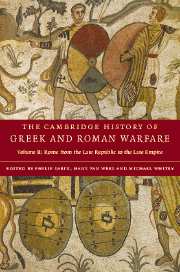
- Cited by 3
-
Cited byCrossref Citations
This Book has been cited by the following publications. This list is generated based on data provided by Crossref.
Shepard, Jonathan 2009. The Cambridge History of the Byzantine Empire c.500–1492.
Cuvigny, Hélène 2014. De l'or pour les braves !. p. 71.
Speidel, Michael A. 2014. De l'or pour les braves !. p. 53.
- Publisher:
- Cambridge University Press
- Online publication date:
- March 2008
- Print publication year:
- 2007
- Online ISBN:
- 9781139054164
- Subjects:
- Ancient History, Classical Studies
- Collection:
- Cambridge Histories - Ancient History & Classics


